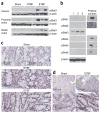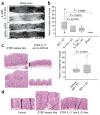A human colonic commensal promotes colon tumorigenesis via activation of T helper type 17 T cell responses
- PMID: 19701202
- PMCID: PMC3034219
- DOI: 10.1038/nm.2015
A human colonic commensal promotes colon tumorigenesis via activation of T helper type 17 T cell responses
Abstract
The intestinal flora may promote colon tumor formation. Here we explore immunologic mechanisms of colonic carcinogenesis by a human colonic bacterium, enterotoxigenic Bacteroides fragilis (ETBF). ETBF that secretes B. fragilis toxin (BFT) causes human inflammatory diarrhea but also asymptomatically colonizes a proportion of the human population. Our results indicate that whereas both ETBF and nontoxigenic B. fragilis (NTBF) chronically colonize mice, only ETBF triggers colitis and strongly induces colonic tumors in multiple intestinal neoplasia (Min) mice. ETBF induces robust, selective colonic signal transducer and activator of transcription-3 (Stat3) activation with colitis characterized by a selective T helper type 17 (T(H)17) response distributed between CD4+ T cell receptor-alphabeta (TCRalphabeta)+ and CD4-8-TCRgammadelta+ T cells. Antibody-mediated blockade of interleukin-17 (IL-17) as well as the receptor for IL-23, a key cytokine amplifying T(H)17 responses, inhibits ETBF-induced colitis, colonic hyperplasia and tumor formation. These results show a Stat3- and T(H)17-dependent pathway for inflammation-induced cancer by a common human commensal bacterium, providing new mechanistic insight into human colon carcinogenesis.
Figures





Comment in
-
STAT3 implicated in the development of colon cancer: a step closer for targeted therapy?Gastroenterology. 2010 Jul;139(1):353-5. doi: 10.1053/j.gastro.2010.05.030. Gastroenterology. 2010. PMID: 20639089 No abstract available.
Similar articles
-
Induction of persistent colitis by a human commensal, enterotoxigenic Bacteroides fragilis, in wild-type C57BL/6 mice.Infect Immun. 2009 Apr;77(4):1708-18. doi: 10.1128/IAI.00814-08. Epub 2009 Feb 2. Infect Immun. 2009. PMID: 19188353 Free PMC article.
-
Stat3 activation in murine colitis induced by enterotoxigenic Bacteroides fragilis.Inflamm Bowel Dis. 2014 May;20(5):821-34. doi: 10.1097/MIB.0000000000000019. Inflamm Bowel Dis. 2014. PMID: 24704822 Free PMC article.
-
Enterotoxigenic Bacteroides fragilis infection exacerbates tumorigenesis in AOM/DSS mouse model.Int J Med Sci. 2020 Jan 1;17(2):145-152. doi: 10.7150/ijms.38371. eCollection 2020. Int J Med Sci. 2020. PMID: 32038097 Free PMC article.
-
Bacteroides fragilis subverts mucosal biology: from symbiont to colon carcinogenesis.J Clin Invest. 2014 Oct;124(10):4166-72. doi: 10.1172/JCI72334. Epub 2014 Aug 8. J Clin Invest. 2014. PMID: 25105360 Free PMC article. Review.
-
Enterotoxigenic Bacteroides fragilis: a rogue among symbiotes.Clin Microbiol Rev. 2009 Apr;22(2):349-69, Table of Contents. doi: 10.1128/CMR.00053-08. Clin Microbiol Rev. 2009. PMID: 19366918 Free PMC article. Review.
Cited by
-
Exploring the gut microbiome's role in colorectal cancer: diagnostic and prognostic implications.Front Immunol. 2024 Oct 17;15:1431747. doi: 10.3389/fimmu.2024.1431747. eCollection 2024. Front Immunol. 2024. PMID: 39483461 Free PMC article. Review.
-
Jianpi-Huatan-Huoxue-Anshen formula ameliorates gastrointestinal inflammation and microecological imbalance in chemotherapy-treated mice transplanted with H22 hepatocellular carcinoma.World J Gastrointest Oncol. 2024 Oct 15;16(10):4209-4231. doi: 10.4251/wjgo.v16.i10.4209. World J Gastrointest Oncol. 2024. PMID: 39473963 Free PMC article.
-
The dynamic crosslinking between gut microbiota and inflammation during aging: reviewing the nutritional and hormetic approaches against dysbiosis and inflammaging.Biogerontology. 2024 Oct 23;26(1):1. doi: 10.1007/s10522-024-10146-2. Biogerontology. 2024. PMID: 39441393 Review.
-
A highly conserved SusCD transporter determines the import and species-specific antagonism of Bacteroides ubiquitin homologues.Nat Commun. 2024 Oct 10;15(1):8794. doi: 10.1038/s41467-024-53149-w. Nat Commun. 2024. PMID: 39389974 Free PMC article.
-
Colorectal cancer-associated bacteria are broadly distributed in global microbiomes and drivers of precancerous change.Sci Rep. 2024 Oct 9;14(1):23646. doi: 10.1038/s41598-024-70702-1. Sci Rep. 2024. PMID: 39384807 Free PMC article.
References
-
- Suerbaum S, Michetti P. Helicobacter pylori infection. N Engl J Med. 2002;347:1175–1186. - PubMed
-
- El Serag HB, Rudolph KL. Hepatocellular carcinoma: epidemiology and molecular carcinogenesis. Gastroenterology. 2007;132:2557–2576. - PubMed
-
- Greten FR, et al. IKKbeta links inflammation and tumorigenesis in a mouse model of colitis-associated cancer. Cell. 2004;118:285–296. - PubMed
-
- Karin M, Greten FR. NF-kappaB: linking inflammation and immunity to cancer development and progression. Nat Rev Immunol. 2005;5:749–759. - PubMed
-
- Naugler WE, et al. Gender disparity in liver cancer due to sex differences in MyD88-dependent IL-6 production. Science. 2007;317:121–124. - PubMed
Publication types
MeSH terms
Substances
Grants and funding
- CA62924/CA/NCI NIH HHS/United States
- R24 DK064388/DK/NIDDK NIH HHS/United States
- R01 DK045496/DK/NIDDK NIH HHS/United States
- 5 T32 HD44355/HD/NICHD NIH HHS/United States
- RR00171/RR/NCRR NIH HHS/United States
- R01 DK080817-02/DK/NIDDK NIH HHS/United States
- R01 DK045496-15/DK/NIDDK NIH HHS/United States
- R01 DK45496/DK/NIDDK NIH HHS/United States
- R01 DK045496-16/DK/NIDDK NIH HHS/United States
- R01 DK045496-17/DK/NIDDK NIH HHS/United States
- R01 DK080817-01/DK/NIDDK NIH HHS/United States
- P50 CA062924/CA/NCI NIH HHS/United States
- R01 DK080817-03/DK/NIDDK NIH HHS/United States
- R01 DK045496-14/DK/NIDDK NIH HHS/United States
- R01 AI089830/AI/NIAID NIH HHS/United States
- T32 HD044355/HD/NICHD NIH HHS/United States
- 2 T32GM066691/GM/NIGMS NIH HHS/United States
- T32 GM066691/GM/NIGMS NIH HHS/United States
- R01 DK080817/DK/NIDDK NIH HHS/United States
- R24 DK64388/DK/NIDDK NIH HHS/United States
- F32 DK079509/DK/NIDDK NIH HHS/United States
- K26 RR000171/RR/NCRR NIH HHS/United States
LinkOut - more resources
Full Text Sources
Other Literature Sources
Molecular Biology Databases
Research Materials
Miscellaneous


